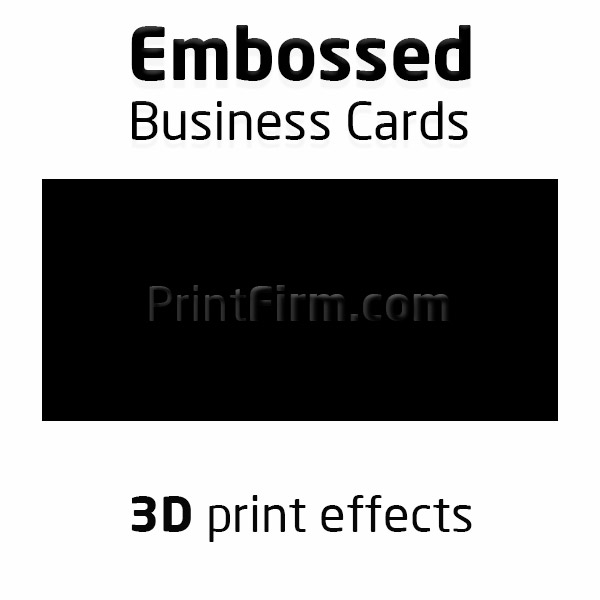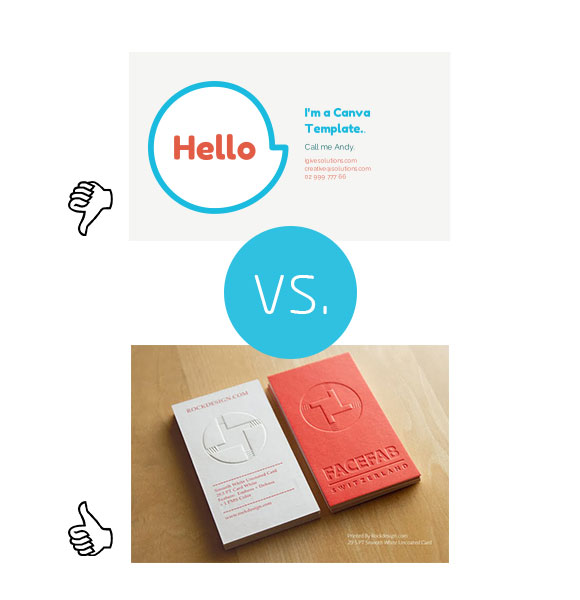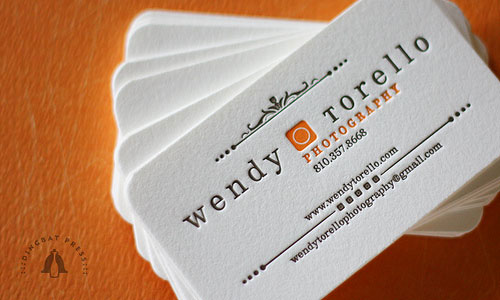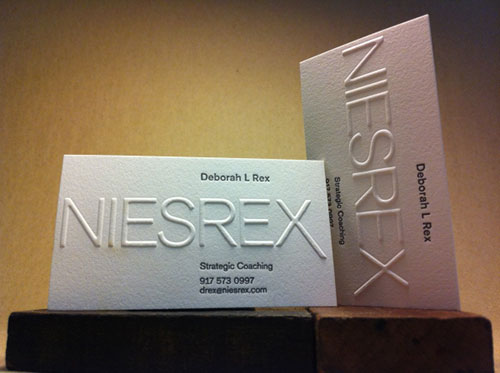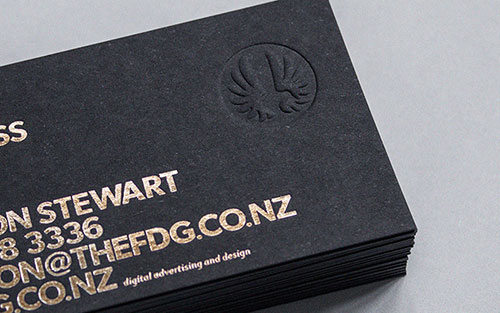Hello inkheads! The other day I noticed an irresistible business card sitting on our manager’s desk (his name is Alex, btw). I picked it up and carefully felt the surface to see if I’d be able to identify the printed effect.
Is this card embossed? I asked.
Yeah, he replied.
Oh well, I thought, must be someone else’s handy work.
So we didn’t print it here at PrintFirm?
Alex gave me a puzzled look.
No, we printed it, he insisted.
Since when do we do embossing?
Since forever, but only for custom jobs.
AHA! Therein lies the missing piece of the puzzle. If you visited the business card product page on our website, you won’t see anything about embossing. When you go to place an order, you won’t find this listed under the product options in our instant pricing calculator. But that doesn’t mean that embossing is out of the question. We fulfill a lot of custom orders, so don’t be afraid to ASK if you don’t see what you’re looking for on our site.
What is embossing?
That said, let’s get to the fun print geeky stuff! Well, the end result is fun…the process leading up to the finished product can be a bit complicated from a technical standpoint. No need to get ahead of ourselves, though. We’ll start off with the definition of embossing:
Emboss v.t. 1. To raise (designs) from a surface; represent in relief. (Free Dictionary)
How does embossing enhance my design?
Ok, embossing and other effects do cost extra—I don’t want to mislead you on pricing. These are not the most budget-friendly options available. If you want cheap cards, then standard options will suit you just fine.
But cheap i.e. inexpensive, commonplace design is by definition forgettable. Your goals with a business card campaign are to make a fantastic first impression and to ensure that prospects/contacts remember you. Embossing your logo or text sticks out in people’s memories because of the unique tactile experience and classy vibe. They will be able to see a difference between yours and the typical card before they get their hands on your cardstock as raised elements catch the eye from a distance. As soon as they feel the detailing on their fingers and the contrast between the flat part of the stock and the raised portion, they’ll stop to examine what they’re touching. They may even ask you about the technique, which gives you a chance to extend the conversation. Either way, the 3D effects on your card get people to focus their attention on your brand instead of slipping the card into their wallets without a second thought.
Embossed vs. Raised Ink business cards
Note: PrintFirm does not do raised ink or letterpress projects. Bummer, I know (letterpress rules!)
By now you might be wondering, what’s the difference between embossing and raised ink? What about letterpress? The answer is it’s all about the process. While these procedures appear similar to the naked eye, they’re quite different in terms of application.
In order to emboss your artwork, we have to create 2 metal dies (kinda like what we do for die cutting). Then we turn up the heat, and press the dies against your cardstock to make a 3 dimensional impression of the graphic.
Source: http://pixelcurse.com/wp-content/uploads/2011/02/TorelloLetterpressBusinessCards53.jpg
Raised ink, also known as Thermography, does not require dies. The cardstock gets heated, and the printer adds powder to the ink before putting it on paper. When the inky powder mixture dries, the ink puffs up with an elevated appearance. There’s no manipulation of the cardstock, and the printer will have a bit more control over the details. For this reason, raised ink or letterpress may be your best bet for intricate artwork.
Think of Letterpress as the opposite of embossing. You don’t need any heat. The printer creates a plate with your image on it and covers the surface with ink. Then the inked plate goes into a letterpress machine where the press operator applies manual pressure to the cardstock. The result will be an imprint or debossed design. Letterpress used to be the only game in town, but today this method would be considered a specialty practice. To get the proper effect, you need very high quality cardstock along with premium inks. Plus, the intimate nature of letterpress limits its mass production capabilities; letterpress is best left to the artisans and craftsmen. Consequently, letterpress projects often cost way more than embossing or raised ink. The results justify the price in my designer’s mind, though…
Can you emboss plastic business cards?
We sure can! Except they’ll melt.
Seriously.
Alex got this exact question from a client last week. Unfortunately, the heating part of our embossing process I explained above means no plastic. We don’t want to hand you a glob o’ melted goop, so we don’t emboss on plastic business cards.
Beautiful embossed card design examples
All right, back to the fun print geek stuff I promised you earlier. Let’s have a looksee at embossing in action for your creative inspiration!
Blind emboss
Source: http://www.studioembossed.com/272/business-card-designs-using-blind-embossing/
You probably noticed that the embossing in the above image doesn’t seem as dramatic as you anticipated. That’s because blind embossing is the most conservative method. Basically, we call the effect blind because we don’t use ink or foil on the embossed portion of the cardstock. You’ll be able to see and feel the impression, yet the effect won’t overpower the rest of your design elements.
Demboss
Source: http://www.studioembossed.com/272/business-card-designs-using-blind-embossing/
Often confused with letterpress, dembossing leaves a sunken in impression of the design in your cardstock. The dembossing process involves heat and not just pressure, which separates the two procedures on a technical level. The imprint will be visible at a glance, and your card will have a clean, tangible element that tempts the touch.
Combination foil stamped and embossed
Source: http://www.underconsideration.com/fpo/project_images/fdg_00.jpg
Any metallic gold or silver in your card design will be too shiny to ignore. Gold foil’s always been a favorite of luxury brands and high end firms who want to attract white collar clients. Foil stands out on its own, yet it doesn’t add a lot to the tactile sensations. The silky smooth feel of foil with a 3D embossed effect gives you an air of distinct credibility.
Embossing tutorials and design resources
Adobe Illustrator embossed tutorial
This easy tutorial explains how to separate your layers in their own PDFs to indicate the embossed portions of your design to the printer. The presenter makes a couple of key points I want to highlight as well. He states that whatever appears embossed on the front of the card appears dembossed on the back (reverse side). You can get around this a bit with super thick cardstock, but most of the time you’ll be dealing with the dembossed situation he describes. He also cautions to keep non-embossed text and graphics away from the embossed elements to avoid printing problems.
InDesign File prep and technique overview
An awesome explanation of lots of different print design effects just for business cards from Smashing Magazine. Embossing is covered, however, not in great detail.
